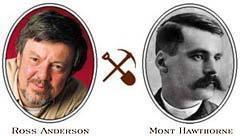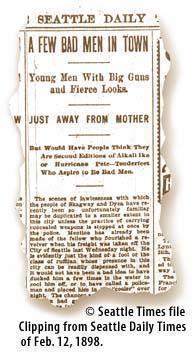
SKAGWAY, Alaska - In the winter of 1897-98, Mont Hawthorne stepped off the steamer George W. Elder and into a northern Heart of Darkness.
Just six months earlier, Skagway had been a remote outpost at the top of Lynn Canal, which juts into the coastal mountains north of Juneau. By mid-winter, it was a seething mass of 5,000 people. Most of them were desperate to cross the mountains to the Klondike gold fields. The rest were looking for ways to mine the miners.
"Things was about as bad as they could get," says Mont.
The town was in winter darkness 16 hours per day. There were saloons on every corner, dance halls, whorehouses, gamblers, swindlers, con men and no legitimate lawmen.
A well-traveled Englishman described it as "the most outrageously lawless quarter I ever struck. . . . It seemed as if the scum of the earth had hastened here to fleece and rob or to murder. . . . Might was right."
 And the unchallenged ruler of this darkness was a notorious bunko artist last seen on
the Seattle waterfront - Jefferson "Soapy" Smith.
And the unchallenged ruler of this darkness was a notorious bunko artist last seen on
the Seattle waterfront - Jefferson "Soapy" Smith.
Minutes after stepping off the ship, Mont was confronted by one of Smith's mob, suspicious of Mont's big piano crate.
"You got a piano," says the thug. "That means you come up here to start a dance hall. And we got something to say about any businesses that opens around here."
Mont would have gotten himself into trouble, but an old friend from Oregon intervened and explained that the box contained not a piano, but Mont's rat-proof Yukon outfit.
Walking through town, Mont encountered a man sitting on his Yukon sled, head in his hands, mumbling to himself. "It's hell. It's hell. Multiply it by ten, and that ain't half as bad as this is."
A century later, Skagway is a long way from hell.
This time of year, it's one part Alaska, two parts Disneyland.
There is barely enough flat land for one main street lined with wooden storefronts, many dating to the gold rush. There's the Klondike Park headquarters, the Skagway News, the Red Onion Saloon (once Smith's headquarters), dozens of gift shops and the venerable Skagway Inn, a one-time brothel converted to a small hotel.
Summer days begin quietly enough - perhaps a few hikers hitching a ride from Dyea Road to the foot of the Chilkoot Trail nine miles away.
But by mid-morning, there is at least one big, white cruise ship anchored in the harbor. By noon, there may be two more, each unleashing its army of tourists - in a single day as many as 6,000 camera-toting seniors, Japanese tour groups, German adventurers and California honeymooners - upon this small village.
Cruise-ship companies favor Skagway for the same reasons the steamers did a century ago: a decent harbor, access to the interior and a town with plenty of entertainment.
Skagway, of course, welcomes the invaders.
With logging in decline, tourists are the local economy. And cruise ships provide most of the tourists - customers for gift shops, tour buses, railroad tours up the pass and back, helicopter rides, whitewater raft trips, ice cream parlors and more.
For eight to 10 hours a day, Skagway teems with bus traffic, honky-tonk piano music, train whistles and chopper flyovers reminiscent of another Heart of Darkness.
But like all economies, the tourist windfall has a price tag. Cruise-ship passengers tax the town's all-volunteer emergency-medic squad -three calls the day I was in town.
The helicopters annoy hikers and others who come for wilderness experiences. Trash generated by tourists compounds headaches at the local dump, which is overflowing - a huge problem in a town where flat land is scarce.
"The cruise companies are trying to be good neighbors," says Sioux Plummer, propietor of the Skagway Inn and town mayor. "We're talking to them about getting medical help during the tourist season. But you also don't want to look a gift horse in the mouth."
Mercifully, the invasions are short-lived. Late in the day, the tourists return to their ships and Skagway heaves a sigh and tallies up its profits.
Come September, the ships become less frequent. By the end of the month, the town throws a party and begins hunkering down for a long winter.
It's a curious life cycle, the flip side to the gold rush. Like other Southeast Alaskan ports, folks here resent the invasions, but also thrive on them.
And perhaps they remember that day, two or 20 years ago, when they stepped off a boat and onto the streets of this northern hideaway, and somehow decided to stay.
Not me. Not for now. One day in the city is plenty for Mont and me. We're gathering our outfits, repacking our gear and gazing up at the coastal mountains and their ice-blue glaciers, feeling the pull of the Klondike gold fields.